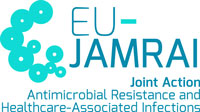Step by step guide for the implementation and assessment of On-the-job Coaching
On-the-job Coaching is a personalized, interactive educational approach where a trained coach (often an expert in AMS/ID) provides real-time training, guidance, non-directive questioning, and constructive feedback to an individual or small group directly within their actual work environment. The aim is to improve performance in specific AMR/AMS-related tasks, enhance decision-making skills, build confidence, and facilitate the practical application of stewardship principles by focusing on real cases and situations.

Planning a On-the-job Coaching
The following steps should be taken into consideration when planning a coaching experience on AMR/AMS:
- Needs Assessment and Goal Setting: Identify specific performance gaps, knowledge/skill deficits, or desired AMS practice improvements for the targeted individual(s) or team. Collaboratively set clear, achievable goals for the coaching period (Khumra et al., 2022; Caekebeke et al., 2021).
- Coach-Coachee Pairing and Scheduling: Match a qualified coach (with AMS expertise and potentially coaching skills) with the coachee(s). Schedule regular, short (e.g., 15-30 min, though Khumra et al., 2022, noted 20 min sessions could be challenging to fit if too frequent) one-on-one sessions directly in the workplace (e.g., on the ward, on the farm) over a defined period (e.g., several weeks to months) (Khumra et al., 2022; Caekebeke et al., 2021).
- Observation and Case-Based Discussion: Coach observes coachee’s routine work (e.g., medication review, prescribing decisions, farm management practices). Discussions are centered on real-time patient cases or farm situations, applying AMS principles (e.g., the ‘4 moments of antibiotic decision-making’ for pharmacists -Khumra et al., 2022-, interpreting diagnostic results, and identifying opportunities for stewardship interventions (Khumra et al., 2022; Caekebeke et al., 2021).
- Guided Practice and Feedback: The coach provides immediate, constructive feedback, models best practices, asks reflective questions to stimulate critical thinking, and supports the coachee in formulating their own recommendations or solutions (Khumra et al., 2022).
- Action Planning and Follow-up: Encourage coachees to develop and implement action plans based on discussions. Review progress, address challenges, and adjust coaching focus in subsequent sessions (Caekebeke et al., 2021).
- Fostering Independence: Gradually transition from coach-led discussions to coachee-led problem-solving and decision-making (Khumra et al., 2022).

Defining roles in a On-the-job Coaching
Facilitator’s role (Coach): Act as a guide and expert resource. Observe performance objectively, ask probing and non-directive questions, provide specific and constructive feedback, model exemplary AMS practices, facilitate problem-solving and goal achievement, identify and address knowledge/skill gaps, and create a supportive environment for learning and reflection. Requires strong AMS knowledge and good coaching/communication skills (Khumra et al., 2022; Caekebeke et al., 2021).
Coachee’s role: Be receptive to observation and feedback, actively participate in discussions about real cases/situations, apply learned AMS principles, take initiative in identifying areas for improvement, formulate and implement action plans or AMS recommendations, and reflect on their practice to enhance skills and confidence (Khumra et al., 2022; Caekebeke et al., 2021).

Assessing a On-the-job Coaching
Methods
- Qualitative feedback from coachees via focus groups or interviews on perceived impact on AMS knowledge, skills, confidence, and practice (Khumra et al., 2022).
- Direct observation of changes in AMS-related behaviors and decision-making in the workplace.
- Documentation and analysis of AMS recommendations made by coachees and their acceptance rates by prescribers/teams (Khumra et al., 2022).
- Changes in quantitative metrics, such as AMU (e.g., Treatment Incidence in Caekebeke et al. (2021), biosecurity scores (Caekebeke et al., 2021), or adherence to specific AMS interventions (e.g., IV-to-oral switch).
- Assessment of attitude change using models like ADKAR® (Caekebeke et al., 2021).
Tools
Interview guides for focus groups, behavioral observation checklists, data collection forms for AMS recommendations/AMU, validated attitude scales (e.g., ADKAR® profile (Caekebeke et al., 2021), performance dashboards (if available).

Suggested On-the-job Coaching prototype
Target Audience: Antimicrobial Manufacturers, Food Producers, Prescribers, Dispensers, Clinical Profiles, Educators.
Learning Objectives:
- Improve coachees’ ability to identify opportunities for AMS interventions during routine patient care (e.g., antimicrobial choice, dose, duration, route, de-escalation) (Khumra et al., 2022).
- Enhance knowledge and practical skills in applying local and national AMS guidelines and interpreting relevant clinical data (microbiology, radiology) (Khumra et al., 2022).
- Increase confidence in communicating AMS recommendations effectively to prescribers and interprofessional teams. (Khumra et al., 2022).
Curriculum/Activities (adapted from Khumra et al., 2022):
- An 8-week coaching program with an experienced ID/AMS pharmacist coach.
- Two to three one-on-one coaching sessions per week per participant, conducted on their respective wards (workplace, real-context), lasting approximately 20-30 minutes.
- Sessions involve reviewing current inpatients receiving systemic antimicrobials.
- Discussions focus on: determining infective syndrome, appropriateness of empirical therapy against guidelines, interpretation of lab tests (microbiology, bloods, radiology), identifying potential AMS recommendations (e.g., IV-to-oral switch, discontinuation, de-escalation, dose optimization), and ensuring appropriate therapy duration (Khumra et al., 2022).
- Coachees are encouraged to refer to guidelines and are shown how to apply them.
- After coaching, the ward pharmacist/clinical profile contacts the treating team to propose discussed recommendations.
- Coach identifies and targets knowledge/skill gaps in subsequent sessions.
Evaluation of the Prototype’s Effectiveness:
- Focus group with participating pharmacists/clinical profiles one month post-coaching to explore perceptions on knowledge, skills, confidence, and practice changes (Khumra et al., 2022).
- Prospective recording of AMS recommendations made by coachees and their acceptance rates by medical teams (Khumra et al., 2022).
- Analysis of the types of AMS interventions identified and implemented.
- Feedback on feasibility, considering workload (Khumra et al., 2022), and potential modifications like targeting junior staff or group coaching elements for efficiency (Khumra et al., 2022).
References
- Caekebeke, N., Ringenier, M., Jonquiere, F., Tobias, T., Postma, M., van den Hoogen, A., Houben, M., Velkers, F., Sleeckx, N., Stegeman, A., & Dewulf, J. (2021). Coaching Belgian and Dutch Broiler Farmers Aimed at Antimicrobial Stewardship and Disease Prevention. Antibiotics, 10(5), 590. https://doi.org/10.3390/antibiotics10050590
- Dik, J.-W. H., Friedrich, A. W., Nathwani, D., & Sinha, B. (2017). Combating the Complex Global Challenge of Antimicrobial Resistance: What Can Antimicrobial Stewardship Contribute? Infectious Disease Reports, 9(1), 7158. https://doi.org/10.4081/idr.2017.7158
- Khadse, S. N., Ugemuge, S., & Singh, C. (2023). Impact of Antimicrobial Stewardship on Reducing Antimicrobial Resistance. Cureus, 15(12), e49935. https://doi.org/10.7759/cureus.49935
- Khumra, S., Mahony, A. A., Stewart, K., Bergen, P. J., & Elliott, R. A. (2022). Coaching ward pharmacists in antimicrobial stewardship: A pilot study. Exploratory Research in Clinical and Social Pharmacy, 5, 100131. https://doi.org/10.1016/j.rcsop.2022.100131
- Nowbuth, A. A., Asombang, A. W., Alaboud, K., Souque, C., Dahu, B. M., Pather, K., Mwanza, M. M., Lotfi, S., & Parmar, V. S. (2023). Gamification as an educational tool to address antimicrobial resistanc e: A systematic review. JAC-Antimicrobial Resistance, 5(6), dlad130. https://doi.org/10.1093/jacamr/dlad130
- Rocha-Pereira, N., Castro Sanchez, E., & Nathwani, D. (2017). How Can Multi-Professional Education Support Better Stewardship? Infectious Disease Reports, 9(1), 6917. https://doi.org/10.4081/idr.2017.6917
- Rocha-Pereira, N., Lafferty, N., & Nathwani, D. (2015). Educating healthcare professionals in antimicrobial stewardship: Can online-learning solutions help? Journal of Antimicrobial Chemotherapy, 70(12), 3175–3177. https://doi.org/10.1093/jac/dkv336
